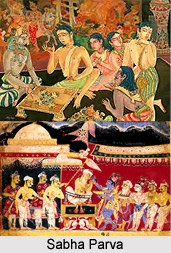 Sabha Parva is also called the episode of the Assembly Hall. This Parva gives an account of Maya Danava who constructed the palace and court or sabha, at Indraprastha. The court life has been described in a very fascinating way in this Parva along with the Rajasuya Yajna which was performed by Yudhisthir and the death of Jarasandha and Sishupala. The game of dice and at last the exile of the Pandavas for twelve years to the forest along with Draupadi and the thirteenth year of exile in disguise. It was also stated that in case the Pandavas were recognized during their thirteenth year of disclosed exile, then they would have to go for another twelve years of exile. Out of the total one hundred sub-parvas of Mahabharata, this Parva consists of nine sub parvas.
Sabha Parva is also called the episode of the Assembly Hall. This Parva gives an account of Maya Danava who constructed the palace and court or sabha, at Indraprastha. The court life has been described in a very fascinating way in this Parva along with the Rajasuya Yajna which was performed by Yudhisthir and the death of Jarasandha and Sishupala. The game of dice and at last the exile of the Pandavas for twelve years to the forest along with Draupadi and the thirteenth year of exile in disguise. It was also stated that in case the Pandavas were recognized during their thirteenth year of disclosed exile, then they would have to go for another twelve years of exile. Out of the total one hundred sub-parvas of Mahabharata, this Parva consists of nine sub parvas.
Indraprasta
After the marriage of Draupadi with the five Pandavas and their alliance with Panchala king Drupada, Dhritarashtra, the king of Hastinapur invited them to the palace and asked Yudhisthir to stay with his brothers in Khandavaprastha in order to avoid the differences between them and Duryodhana. The eldest Pandava gave his consent and set out from Hastinapur. With half the kingdom, the Pandavas were removed to Khandavaprastha which was actually in a desert. The Pandavas, with Krishna arrived there and beautified the place as a second heaven. Several Brahmins, well-acquainted with the Vedas, came to the newly-constructed kingdom in order to dwell there. Several merchants also came to that town hoping to earn wealth. A number of beautiful gardens were constructed around the city with several trees bearing fruits and flowers.
For the beautification of the city, the close-by forest of Khandava was burnt by Arjuna and Krishna. Arjuna encompassed the entire forest with several arrows like a thick fog and no living creature was able to escape from below. However, Arjuna did not kill Maya, powerful demon, and the asura became an ally of the Pandavas. Maya showed his gratitude by constructing a very beautiful palace for the Pandavas at Indraprastha.
The Sabha Parva is also the second Parva of the great epic Mahabharata which narrates the Rajasuya Yajna of Yudhisthir. It also describes the death of Jarasandha and also the death of Shishupala.
Game of Dice
Game of dice was the turning point in the life of the Pandavas and the Kauravas. After the imperial sacrifice by Yudhisthir was over, Duryodhana stayed for some time at Indraprasta. Experiencing the beautiful architectural design of the palace, the eldest son of Dhritarashtra became jealous of the Pandavas and started working out evil means to get Indraprasta from them. Thus he worked out a plan with his uncle Shakuni and invited the Pandavas for a game of dice. As a noble king Yudhisthir was not able to reject any challenge for war or for game, and thus he accepted the challenge and along with his brothers reached Hastinapur. In the fatal game of dice, Yudhisthir lost himself along with his brothers and also Draupadi. Draupadi was also misbehaved in the Kuru sabha and the Pandavas were ultimately exiled into the forest with Draupadi for twelve years and the thirteenth year in unrecognized state. In case they were recognized in their exile in the thirteenth year, they would again go for another exile of twelve years. Thus, the Pandavas, after losing everything in the game, left Hastinapur for the jungle along with Draupadi. While the five sons of Draupadi went forth, grim and silent, to their exile, wise men were able to mark the manner of their departure and visualized a terrible return, a return which would be disastrous to all their foes.
Thus, the second Parva of Mahabharata narrates the incidents of the erection of the beautiful palace at Indraprasta. The demon Maya promised to reward Arjuna by his artistic talents. However, Lord Krishna, the God of the universe and the Creator of every object commanded Maya to construct such a palatial sabha or meeting hall that persons belonging to the mortal world may not be able to imitate it even after examining it with care, while seated within. In the Sabha Parva of the Mahabharata, it is aptly described that Maya constructed a palace of illusions called the Maya Sabha at Indraprasta. It was full of artificial ponds and lakes as well as natural ponds and lakes. The Parva also describes all the incidents including the Rajasuya Yajna by Yudhisthir, the death of Jarasandha and Sishupala, the game of dice and ultimate exile of the Pandavas.



















